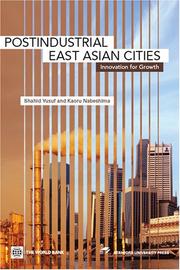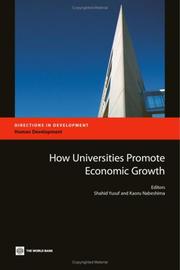| Listing 1 - 10 of 35 | << page >> |
Sort by
|
Digital
Year: 2003 Publisher: Washington, D.C. World Bank
Abstract | Keywords | Export | Availability | Bookmark
 Loading...
Loading...Choose an application
- Reference Manager
- EndNote
- RefWorks (Direct export to RefWorks)
Book
ISBN: 9780821378809 0821378805 9780821380611 0821380613 9786612335037 1282335030 Year: 2009 Publisher: Washington, D.C. : London : World Bank ; Eurospan [distributor],
Abstract | Keywords | Export | Availability | Bookmark
 Loading...
Loading...Choose an application
- Reference Manager
- EndNote
- RefWorks (Direct export to RefWorks)
Southeast Asian tiger economies feel threatened by competition from other countries and worry that their growth momentum might be flagging. Even though their growth rates are above the average for the world and for developing countries, they fall short of yesterday's economic performance. The underlying worry is that they presage the beginning of a downward trend, the harbingers of which are lower rates of investment, persistently low rates of total factor productivity and low levels of innovativeness. The South East Asian tigers' worries motivate three questions: First, are the tigers rightly
Industries --- Industrial policy --- Technological innovations --- Industrie --- Politique industrielle --- Innovations --- Marketing --- Industrial policy -- Malaysia. --- Malaysia -- Industries. --- Technological innovations -- Economic aspects -- Malaysia. --- Business & Economics --- Economic aspects --- Breakthroughs, Technological --- Innovations, Industrial --- Innovations, Technological --- Technical innovations --- Technological breakthroughs --- Technological change --- Creative ability in technology --- Inventions --- Domestication of technology --- Innovation relay centers --- Research, Industrial --- Technology transfer

ISBN: 0804756724 0821356224 9786610564514 1280564512 0821366491 9780821356227 9780804756723 9780821366493 Year: 2006 Publisher: Palo Alto, CA : Washington, DC : Stanford Economics and Finance ; World Bank,
Abstract | Keywords | Export | Availability | Bookmark
 Loading...
Loading...Choose an application
- Reference Manager
- EndNote
- RefWorks (Direct export to RefWorks)
Post-Industrial East Asian Cities analyzes urban developments and policies responsible for the growth of producer services and creative industries. This study is based on the findings of firm surveys conducted in East Asia and a review of the data and literature on several key regional cities (Beijing, Shanghai, Singapore, Seoul, Bangkok and Tokyo) that are transitioning away from traditional manufacturing activities.
Cities and towns. --- Cities and towns --- Service industries --- Technological innovations --- Sociology & Social History --- Social Sciences --- Communities - Urban Groups --- Economic aspects --- #SBIB:39A4 --- #SBIB:39A75 --- #SBIB:316.334.5U20 --- Industries --- Global cities --- Municipalities --- Towns --- Urban areas --- Urban systems --- Human settlements --- Sociology, Urban --- Toegepaste antropologie --- Etnografie: Azië --- Sociologie van stad (buurt, wijk, community, stadsvernieuwing) --- East Asia --- Asia, East --- Asia, Eastern --- East (Far East) --- Eastern Asia --- Far East --- Orient --- Economic policy. --- Economic conditions
Book
ISBN: 0821382403 9786612818844 0821384384 1282818848 Year: 2010 Publisher: Washington, D.C. : World Bank,
Abstract | Keywords | Export | Availability | Bookmark
 Loading...
Loading...Choose an application
- Reference Manager
- EndNote
- RefWorks (Direct export to RefWorks)
A great burst of globalization brought the 20th century to a close, creating upheaval in the world economy from roughly 1995 to 2008. And now a second upheaveal is in the offing following the severe financial crisis that plunged the global economy into recession in 2008-09. The first upheaval witnessed a massive migration of manufacturing and certain business services that transformed Asia into the industrial heartland of the world. The second upheaval will likely consolidate Asia's industrial preeminence and could result in a concentration of industrial activities in the two most populous and
China -- Economic policy -- 2000-. --- China -- Foreign economic relations. --- India -- Economic policy -- 1991-. --- India -- Foreign economic relations. --- Industrialization -- Asia. --- Industrialization -- China. --- Industrialization -- India. --- Industrialization --- Business & Economics --- Economic History --- China --- India --- Economic policy --- Foreign economic relations. --- Industrial development --- Economic development --- Deindustrialization --- Bharat --- Bhārata --- Government of India --- Ḣindiston Respublikasi --- Inde --- Indië --- Indien --- Indii︠a︡ --- Indland --- Indo --- Republic of India --- Sāthāranarat ʻIndīa --- Yin-tu --- インド --- هند --- Индия

ISBN: 1280725605 9786610725601 0821367528 082136751X 9780821367513 Year: 2006 Publisher: Washington, DC : World Bank,
Abstract | Keywords | Export | Availability | Bookmark
 Loading...
Loading...Choose an application
- Reference Manager
- EndNote
- RefWorks (Direct export to RefWorks)
With technological capability increasingly becoming the touchstone of competitiveness in an open and integrated world environment, the role of universities in economic growth is taking on a greater salience. Not only do they impart education but also they are coming to be viewed as sources of industrially valuable technical skills, innovations and entrepreneurship. Realizing this potential of universities so as to spur growth is now a priority in developed and developing countries. This calls for coordinated policy actions. The distinguished contributors to this volume examine the wealth of in
Business and education --- Economic development --- Technology transfer --- Education and state --- Effect of education on --- Academic-industrial collaboration --- -Business and education --- -338.4 --- Corporations and education --- Industry and education --- Education and business --- Education and corporations --- Education and industry --- Worksite schools --- Collaboration, Academic-industrial --- Collaboration, Industrial-academic --- Industrial-academic collaboration --- Industrial-university collaboration --- University-industrial collaboration --- Industrie et éducation --- Effets de l'éducation sur --- Développement économique --- Transfert de technologie --- Education --- Congresses. --- Congrès --- Politique gouvernementale
Book
ISBN: 0821380486 9786612462573 0821381288 1282462571 9780821380482 Year: 2010 Publisher: Washington World Bank
Abstract | Keywords | Export | Availability | Bookmark
 Loading...
Loading...Choose an application
- Reference Manager
- EndNote
- RefWorks (Direct export to RefWorks)
Beijing and Shanghai comprise the axes of China's two leading urban regions. Their economic fortunes will affect the overall growth of China. The economic composition of the two megacities differs significantly and the future sources of competitive advantage also lie in different areas although there is some overlap. Shanghai with its diverse industrial base is the industrial powerhouse of China. Its strongest growth prospects still lie in activities associated with manufacturing industry buttressed by improvements in the technological and innovation capabilities of domestic firms and supporte
Economic development --- Development, Economic --- Economic growth --- Growth, Economic --- Economic policy --- Economics --- Statics and dynamics (Social sciences) --- Development economics --- Resource curse --- Beijing (China) --- Shanghai (China) --- Economic policy. --- Shanghai --- Changhaï (China) --- Shang-hai (China) --- Shang hai shi (China) --- Shanghai Shi (China) --- Shanghai Municipality (China) --- Shanghai Shi ren min zheng fu (China) --- Shankhaĭ (China) --- Xangai (China) --- 上海 (China) --- Ṣămhayi (China) --- Beijing Shi (China) --- Begejing (China) --- Begejing Qota (China) --- Bėėzhin (China) --- Бээжин (China) --- Peiping (China) --- Peping (China) --- Pekin (China) --- Pei-ching shih (China) --- Pei-pʻing shih (China) --- Peking (China) --- Pukkyŏng (China) --- Beijing Municipality (China) --- Bei Jing Shi (China) --- Pei-ching (China) --- Pechino (China) --- Pequim (China) --- Peiping Municipal Administrative Area (China) --- Peiping Municipality (China) --- Peking Municipality (China) --- Bījīn (China) --- Dadu (China) --- Daidu (China) --- 北京 (China) --- Beiping Tebieshi zheng fu --- Beiping Shi zheng fu --- Beiping Shi di fang wei chi hui --- Beijing di fang wei chi hui --- Beijing Tebieshi zheng fu --- Beijing Tebieshi gong shu --- Beijing Shi ren min zheng fu --- Beijing Shi ren min wei yuan hui --- Beijing Shi ge ming wei yuan hui --- Bewoning leefgemeenschap. --- Geografie --- Sociale geografie --- Bewoning en leefgemeenschap. --- S03/0631 --- S03/0633 --- S11/0470 --- China: Geography, description and travel--Beijing (incl. concessions) --- China: Geography, description and travel--Shanghai (incl. concessions) --- China: Social sciences--Cities: since 1949 --- Chang-hai (China) --- Schanghai (China) --- 上海市(China) --- 上海市人民政府 (China) --- Шанхай (China) --- Śangqai (China)
Book
ISBN: 0821365096 9780821365090 082136510X 9780821365106 9786610447534 1280447532 Year: 2006 Publisher: Washington, DC : World Bank,
Abstract | Keywords | Export | Availability | Bookmark
 Loading...
Loading...Choose an application
- Reference Manager
- EndNote
- RefWorks (Direct export to RefWorks)
Over the past two decades China's growth has been rapid, social indicators have improved, and poverty levels have inched downward. However,widening inequality, increasing resource and financial imbalances, and growing environmental concerns provide China with daunting challenges in improving the quality of growth. The rapid growth that will remain China's principal vehicle for raising standards of living and reducing poverty will derive from urbanization, increased market efficiency, and improvement in the technological capability of Chinese firms. But although growth will be critically import
Economic policy and planning (general) --- China --- Chine --- Economic policy. --- Economic conditions. --- Politique économique --- Conditions économiques --- Economics. --- Economic theory --- Political economy --- Social sciences --- Economic man --- S10/0251 --- China: Economics, industry and commerce--General works and economic history: since 1989
Digital
Abstract | Keywords | Export | Availability | Bookmark
 Loading...
Loading...Choose an application
- Reference Manager
- EndNote
- RefWorks (Direct export to RefWorks)
Digital
ISBN: 0821365096 9780821365090 082136510X 9780821365106 Year: 2006 Publisher: Washington, D.C. World Bank
Abstract | Keywords | Export | Availability | Bookmark
 Loading...
Loading...Choose an application
- Reference Manager
- EndNote
- RefWorks (Direct export to RefWorks)
Book
Abstract | Keywords | Export | Availability | Bookmark
 Loading...
Loading...Choose an application
- Reference Manager
- EndNote
- RefWorks (Direct export to RefWorks)
China is increasing its outlay on research and development and seeking to build an innovation system that will deliver quick results not just in absorbing technology but also in pushing the technological envelope. China's spending on R&D rose from 1.1 percent of GDP in 2000 to 1.3 percent of GDP in 2005. On a purchasing power parity basis, China's research outlay was among the world's highest, far greater than that of Brazil, India, or Mexico. Chinese firms are active in the fields of biotechnology, pharmaceuticals, alternative energy sources, and nanotechnology. This surge in spending has been parallel by a sharp increase in patent applications in China, with the bulk of the patents registered in the areas of electronics, information technology, and telecoms. However, of the almost 50,000 patents granted in China, nearly two-thirds were to nonresidents. This paper considers two questions that are especially important for China. First, how might China go about accelerating technology development? Second, what measures could most cost-effectively deliver the desired outcomes? It concludes that although the level of financing for R&D is certainly important, technological advance is closely keyed to absorptive capacity which is a function of the volume and quality of talent and the depth as well as the heterogeneity of research experience. It is also a function of how companies maximize the commercial benefits of research and development, and the coordination of research with production and marketing.
Agricultural Knowledge and Information Systems --- Agriculture --- E-Business --- Education --- Electronics --- Engineering --- Equipment --- ICT Policy and Strategies --- Industry --- Information and Communication Technologies --- Information technology --- Innovations --- Nanotechnology --- New technologies --- Private Sector Development --- Rural Development --- Technological capabilities --- Technological Capability --- Technology Industry --- Technology transfer --- Tertiary Education
| Listing 1 - 10 of 35 | << page >> |
Sort by
|

 Search
Search Feedback
Feedback About UniCat
About UniCat  Help
Help News
News